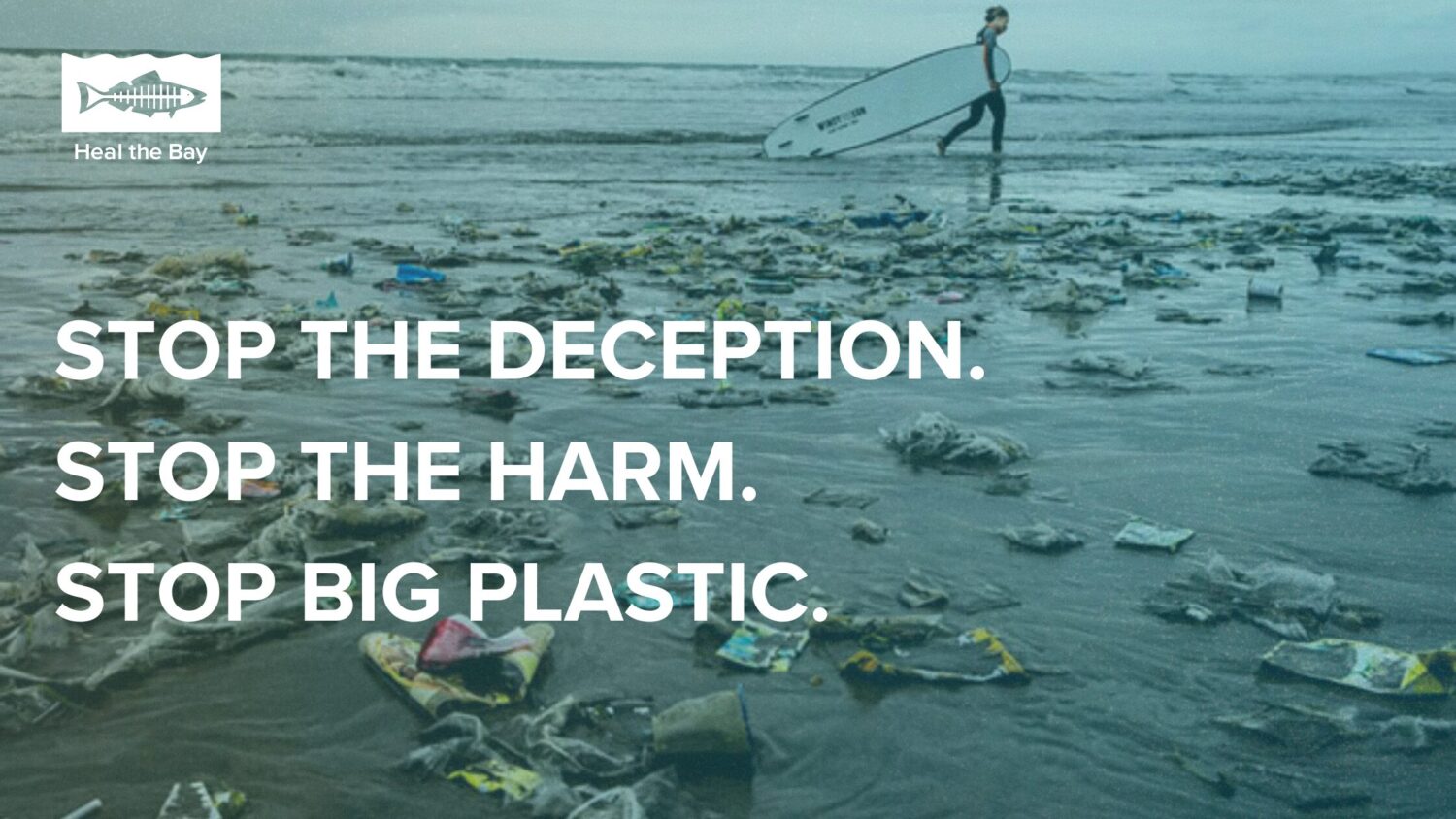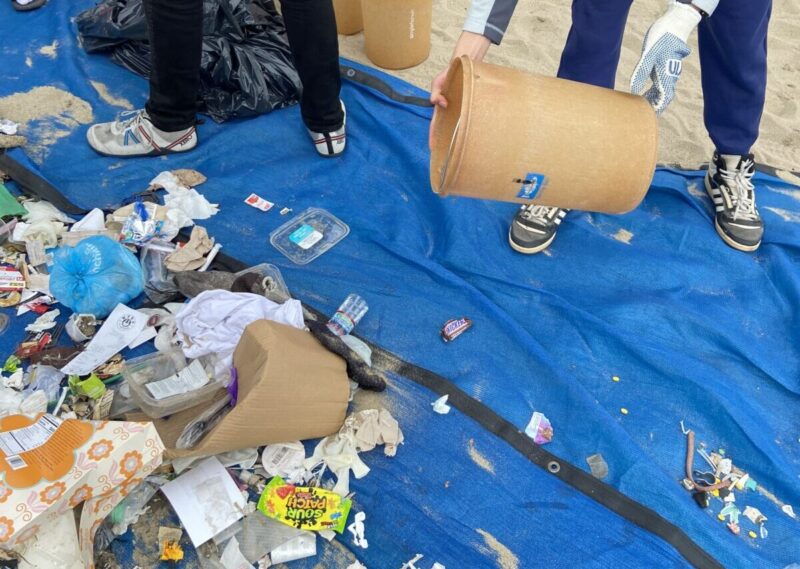HEAL THE BAY SUES BIG PLASTIC – Heal the Bay


Heal the Bay Takes Historic Legal Action to Combat Plastic Pollution

Heal the Bay today took historic legal action to put an end to one of the existential threats facing our local beaches and ocean – plastic pollution.
We have joined a coalition of leading environmental groups in filing a lawsuit against ExxonMobil, the world’s largest producer of single-use plastic polymers. California’s Attorney General also filed a similar lawsuit today.
For the past 40 years, we’ve hosted tens of thousands of beach cleanups in L.A. County. Our volunteers have removed over 2 million pounds of plastic-strewn trash from our shorelines and inland waterways.
Today, we say “No more!”
Instead of cleaning up the wreckage created by Big Plastic, we are moving aggressively to stop the harm at its source.
What Legal Action Did Heal the Bay Take Today?
The coalition complaint, filed in San Francisco Superior Court, alleges violations of California’s nuisance law and unfair competition law. In the suit, the plaintiffs argue there must be corporate accountability for a decades-long campaign to bury the truth about the known environmental, economic, and human health impacts caused by plastics.
The bold action harkens back to Heal the Bay’s first victory in 1990 when it successfully secured a legal settlement with the City of Los Angeles to stop dumping partially treated sewage into the Bay from its Hyperion wastewater treatment facility.
Who Else Is Backing the Lawsuits Against ExxonMobil?
For months, Heal the Bay’s policy staff has been quietly meeting with our peers at Surfrider Foundation, the Sierra Club, and San Francisco Baykeeper. Today’s action marks the first step in a coordinated campaign to legally hold Big Oil accountable for the production of wasteful and harmful single-use plastics.
In April 2022, California Attorney General Rob Bonta launched an investigation into ExxonMobil (and other fossil fuel industry giants) for their role in the plastic pollution problem. Based on those findings, Bonta’s office today filed a concurrent lawsuit against Big Plastic. This marks a more aggressive approach to stop plastic pollution at its source rather than merely remediating it.
What Are the Environmental Harms Created by ExxonMobil?
As alleged in the complaint, ExxonMobil-produced polymer resins are responsible for over 6 million metric tons of plastic waste annually — equivalent to the weight of 300,000 garbage trucks. Polymers are used to produce so-called “nurdles.” These BB-sized plastic pellets are the building blocks of such wasteful and harmful single-use items as plastic bags, water bottles, and snack packaging. This debris winds up contaminating our environment and our bodies, at every stage of its product lifecycle. By 2050, there will be more plastic in the world’s oceans than fish, according to some studies.
Why Can’t We Just Do a Better Job of Recycling Single-Use Plastics?
Even with recycling programs in place for decades, less than 5% of domestic plastic is recycled into another plastic product, despite being labeled as “recyclable.” The vast majority of plastics end up littering our public places, winding up in overtaxed landfills, or floating in garbage vortexes in our oceans.
What Are the Ties Between Single-Use Plastics and the Worsening Climate Crisis?
Given falling demand for gasoline as electric cars proliferate, plastics will be the greatest growth market for Big Oil in the next decade.
Plastic production and disposal are also a significant contributor to ever-worsening climate change, responsible for roughly 3% of all carbon emissions worldwide. The doubling of plastics production in the next two decades will contribute to the wildfires, famine, and heat stroke that jeopardize the lives of millions.
How Has Plastic Harmed Our Bodies?
Plastic pollution never biodegrades. Instead, plastic pollution breaks down into smaller and smaller pieces — sometimes referred to as microplastics. Avoiding microplastics in our daily lives is virtually impossible. It is in our drinking water, it is in the food we eat, and it is even in the air we breathe.
Over the course of a lifetime, the average person will unknowingly consume more than 40 pounds of plastic. Microplastics have been found in human blood, heart tissue, placentas, and even breast milk.

A Heal the Bay volunteer sorts through plastic pollution on a Southern California beach.
How Can Our Supporters Help?
Today’s filing is just the first step in what could be a years-long legal fight. Just as with our victory at Hyperion, a steady application of grassroots pressure will be required to force deep-pocketed Big Oil to change its harmful practices.
We will be calling on all our supporters in the coming months to add their voices to the chorus of everyday people fed up with single-use plastics. We will also need the financial assistance of donors to help defray costs associated with the lawsuit.
What Are the Next Steps?
In the next few months, Heal the Bay’s science and policy team will continue to gather data to hold Big Oil’s feet to the fire.
DONATE TO SUPPORT THIS LEGAL ACTION
Today is just the first day in a long fight.
To receive regular updates on how you can make your voice heard, please click here.
SDGs, Targets, and Indicators
1. Which SDGs are addressed or connected to the issues highlighted in the article?
- SDG 12: Responsible Consumption and Production
- SDG 13: Climate Action
- SDG 14: Life Below Water
- SDG 15: Life on Land
The article discusses the issue of plastic pollution and its environmental, economic, and human health impacts. These issues are directly related to SDG 12, which aims to ensure sustainable consumption and production patterns. Plastic pollution also contributes to climate change, making it relevant to SDG 13 on climate action. Additionally, plastic pollution affects marine life and ecosystems (SDG 14) and terrestrial ecosystems (SDG 15).
2. What specific targets under those SDGs can be identified based on the article’s content?
- SDG 12.5: By 2030, substantially reduce waste generation through prevention, reduction, recycling, and reuse.
- SDG 13.3: Improve education, awareness-raising, and human and institutional capacity on climate change mitigation, adaptation, impact reduction, and early warning.
- SDG 14.1: By 2025, prevent and significantly reduce marine pollution of all kinds, particularly from land-based activities, including marine debris and nutrient pollution.
- SDG 15.1: By 2020, ensure the conservation, restoration, and sustainable use of terrestrial and inland freshwater ecosystems and their services, in particular forests, wetlands, mountains, and drylands, in line with obligations under international agreements.
Based on the article, the targets mentioned above are relevant to address the issues of plastic pollution, waste reduction, climate change mitigation, marine pollution prevention, and conservation of ecosystems.
3. Are there any indicators mentioned or implied in the article that can be used to measure progress towards the identified targets?
- Indicator 12.5.1: National recycling rate, tons of material recycled
- Indicator 13.3.1: Number of countries that have integrated mitigation, adaptation, impact reduction, and early warning measures into relevant policies, strategies, or planning
- Indicator 14.1.1: Index of coastal eutrophication and floating plastic debris density
- Indicator 15.1.1: Forest area as a proportion of total land area
The article does not explicitly mention these indicators, but they can be used to measure progress towards the identified targets. These indicators provide measurable data on recycling rates, integration of climate change measures, marine pollution levels, and forest conservation.
Table: SDGs, Targets, and Indicators
| SDGs | Targets | Indicators |
|---|---|---|
| SDG 12: Responsible Consumption and Production | Target 12.5: By 2030, substantially reduce waste generation through prevention, reduction, recycling, and reuse. | Indicator 12.5.1: National recycling rate, tons of material recycled |
| SDG 13: Climate Action | Target 13.3: Improve education, awareness-raising, and human and institutional capacity on climate change mitigation, adaptation, impact reduction, and early warning. | Indicator 13.3.1: Number of countries that have integrated mitigation, adaptation, impact reduction, and early warning measures into relevant policies, strategies, or planning |
| SDG 14: Life Below Water | Target 14.1: By 2025, prevent and significantly reduce marine pollution of all kinds, particularly from land-based activities, including marine debris and nutrient pollution. | Indicator 14.1.1: Index of coastal eutrophication and floating plastic debris density |
| SDG 15: Life on Land | Target 15.1: By 2020, ensure the conservation, restoration, and sustainable use of terrestrial and inland freshwater ecosystems and their services, in particular forests, wetlands, mountains, and drylands, in line with obligations under international agreements. | Indicator 15.1.1: Forest area as a proportion of total land area |
Source: healthebay.org








